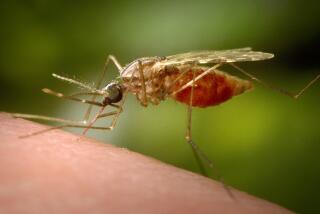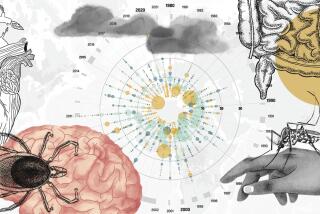MEDICINE / TROPICAL DISEASES : Afflictions Expected to Kill 4 Million Annually by 2010
- Share via
Tropical diseases--one of the world’s most pressing, and most ignored, public health threats--are spreading rapidly and could kill 4 million people each year by 2010, twice as many lives as they claim now, the World Health Organization announced Monday.
In an urgent call for new research, the agency reported that one of every 10 people in the world--a staggering 500 million--suffer from at least one of the eight most common tropical diseases, with malaria alone infecting about 270 million.
By contrast, an estimated 13 million people worldwide are infected with the virus that causes AIDS, and about 2.5 million have died since the epidemic began a decade ago.
While the U.S. government alone spends more than $1.19 billion each year on AIDS research, WHO’s tropical disease branch--which is funded by the United Nations, the World Bank and the governments of the United States, Great Britain, Norway and Sweden, among other nations--spends just $35 million per year to do research on all tropical diseases.
The WHO announcement in Washington, drawn from a study to be published next month, is designed to highlight that disparity. The agency is hoping to persuade the governments of industrialized nations, including the United States, to fund more research into development of drugs and vaccines to combat tropical diseases.
“These diseases, together with acute respiratory infections, diarrheal diseases, tuberculosis and AIDS are the leading infectious diseases in the world,” said Dr. Tore Godal, director of WHO’s Tropical Disease Research Programme, which issued the report. “Yet (tropical diseases) are given less attention because they affect poor people in poor countries.”
According to WHO, population growth, coupled with strains of drug-resistant malaria, environmental changes and economic upheavals, is fueling the spread of these diseases. Most of the deaths occur in children under 5, experts say.
“If you do an analysis of preventable death, an enormously higher number of infants and children undoubtedly die of malaria in Africa than have collectively died of AIDS up to the present time,” said Dr. Karl Western, a specialist in tropical diseases at the National Institutes of Health.
To meet its research targets, WHO’s tropical disease budget would have to double, Godal said. Monday’s announcement outlined 50 research goals, including identifying 10 new possible malaria drugs by 1995 and completing tests on a vaccine by 2002.
Experts say little, if any, private research is conducted in the area of tropical disease because pharmaceutical companies cannot profit from developing drugs for nations that cannot afford to buy them. Thus the task has been left to the World Health Organization, which began its research program 15 years ago.
A notable exception has been treatment of river blindness, which has been on the decline within the past decade, ever since the pharmaceutical firm Merck & Co. developed the drug ivermectin, which cures it. Merck initially developed the treatment for veterinary use, but when researchers discovered it worked against river blindness, the company donated the drug to affected nations.
“It’s one of the great tropic stories of our time,” said Dr. Peter Heseltine, an infectious disease specialist at USC.
Since WHO began its initiative, significant strides have also been made in fighting leprosy and Chagas’ disease, an incurable disorder that affects the heart, digestive system and brain. WHO reported that the prevalence of each of these diseases is expected to decline over the next decade, with the introduction of new drugs.
But at the same time, five other major tropical diseases are spreading rapidly and WHO has been forced to abandon its earlier goal of eradicating malaria by the year 2000.
“We are losing the battle on a number of grounds,” said Heseltine, “and the so-called goals for 2000 are even a little bit further away, which is really depressing.”
In addition to malaria, the other major tropical diseases are: schistosomiasis, which is transmitted through tainted water and causes severe damage to internal organs; lymphatic filariasis, in which parasites, spread by mosquitoes, develop into worms that infect the body’s lymph system; African sleeping sickness, in which a parasite transmitted by the tsetse fly causes an inflammation in the brain; and leishmaniasis, which causes skin lesions and is spread by blood-sucking sand flies.
These diseases are treatable, but they are often diagnosed late and most of those affected cannot afford the necessary treatment.
Tropical diseases pose little threat to Americans and other people of developed nations, aside from travelers and military troops sent to areas in which these illnesses flourish. Some U.S. soldiers taking part in the Gulf War, for instance, contracted leishmaniasis. But beyond that, most residents of developed countries have never heard of them. Western, the National Institutes of Health specialist, says that is the reason they have been allowed to proliferate.
“The crude point is that, for practical purposes, most of the world hasn’t cared,” said Western. “We sometimes get very emotionally involved or excited with famine in Somalia or the Sudan. A starving skeleton of a child is a very emotional thing. But most of these kids don’t die of pure famine; they get an infectious disease agent which knocks them off.”
Tropical Disease Infections
One out of every 10 people in the world--an estimated 500 million people--suffer from at least one of the eight major tropical diseases:
DISEASE PEOPLE INFECTED PEOPLE AT RISK Malaria 267,000,000 2,100,000,000 Schistosomiasis 200,000,000 600,000,000 Lymphatic Filariasis 78,600,000 905,000,000 River Blindness 17,600,000 90,000,000 Chagas’ Disease 17,000,000 90,000,000 Leishmaniasis 12,000,000 350,000,000 Leprosy 100,000,000 1,600,000,000 African Sleeping Sickness 100,000 50,000,000
--Source: World Health Organization, 1993






